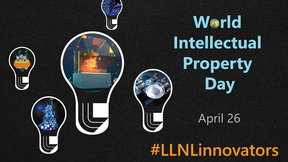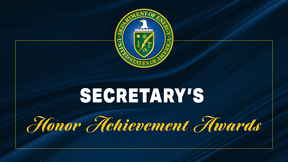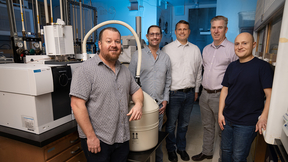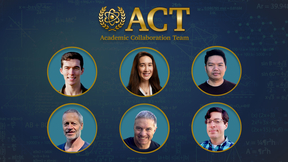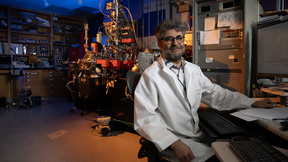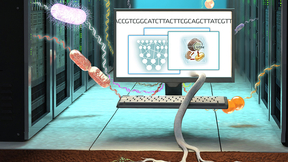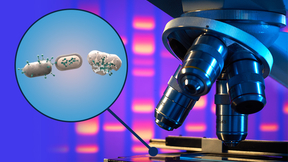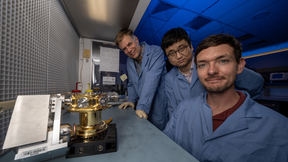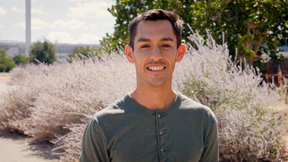Back
Nuclear and Chemical Sciences
Lab scientist wins Springer Thesis Award for work in neutrino research
Lawrence Livermore National Laboratory (LLNL) postdoc Sam Hedges has won a 2024 Springer Thesis Award for his work in searching for the elusive neutrino. “I’m honored that my thesis was nominated for this award, and was excited when I found out it had won,” Hedges said. His thesis, “Low Energy Neutrino-Nucleus Interactions at the Spallation Neutron Source," highlights the…
Pett-Ridge selected as a 2024 Ecological Society of America fellow
Lawrence Livermore National Laboratory (LLNL) scientist and head of the Lab’s Carbon Initiative Jennifer Pett-Ridge has been selected as a fellow of the Ecological Society of America (ESA). ESA designates fellows of the society for certain members who have made outstanding contributions to a wide range of fields served by ESA. Pett-Ridge was selected for her work in soil…
Celebrating LLNL researchers on World Intellectual Property Day
World Intellectual Property (IP) Day is Friday, April 26. World IP Day shines a light on the important role innovation plays in achieving the United Nations’ (UN) 17 Sustainable Development Goals (SDGs), which aim to create a better future for everyone by protecting the planet. Lawrence Livermore National Laboratory’s (LLNL)’s Innovation and Partnerships Office (IPO) is…
Five Lab postdocs will attend 73rd annual Lindau Nobel Laureate meetings
Getting the chance to meet and mingle with scientists who have achieved Nobel Prize winning greatness will be the reality for five Lawrence Livermore National Laboratory (LLNL) postdoctoral appointees selected to attend the 73rd annual Lindau Nobel Laureate meetings. Tina Ebert, Elizabeth Grace and Raspberry Simpson were selected as the 2024 LLNL cohort; Tomi Akindele and…
Algal activities shape surrounding bacterial communities
Microalgae play important roles in global carbon cycling and industrial applications for bioproduct and biofuel production. As with land plants and other host–microbial systems, microalgal activity, productivity, and stability are closely tied to surrounding microbial communities. However, a predictive understanding of microbial community interactions with algae is still…
Understanding soil carbon's sensitivity to increasing global temperatures
Particulate soil carbon may be more vulnerable to microbial decomposition under warmer temperatures associated with climate change. Soil organic matter contains more carbon than plants and the atmosphere combined. Soil is increasingly considered for its potential role in climate mitigation due to its ability to sequester more carbon, but it also is critical to understand…
Lab employees recognized with Secretary of Energy’s Honor Awards
Lawrence Livermore National Laboratory (LLNL) employees, participating in five project teams, recently earned Department of Energy (DOE) Secretary’s Honor Awards. In addition, Karin King of the Livermore Field Office was honored for her role in the Leadership in Climate Action Team. Representing some of the highest internal, non-monetary recognition that DOE employees and…
Hot stuff: A new thermal pathway for a high explosive
TATB (1,3,5-triamino-2,4,6-trinitrobenzene) is an important explosive compound because of its extensive use in munitions and world-wide weapons systems. Despite its importance, researchers have been trying to understand its response to temperature extremes for the past 50 years. A Lawrence Livermore National Laboratory (LLNL) team has uncovered a new thermal decomposition…
Strategic Deterrence Academic Collaboration Team awards six scientists to support collaborative research
Six scientists at the Lawrence Livermore National Laboratory (LLNL) were recently granted awards through the Lab’s 2023 Academic Collaboration Team (ACT) annual call for proposals. Awards support university research partners for up to three years to perform research in collaboration with Lab scientists and offer an important way to build long-term connections with…
Microbial research unravels a global nitrogen mystery
Ammonia-oxidizing microorganisms (AOM) use ammonia for energy and account for the annual oxidation of approximately 2.3 trillion kilograms of nitrogen in soil, freshwater, the subsurface and man-made ecosystems. But one major question that has remained unanswered for decades is how different AOM species coexist in the same environment: do they compete for ammonia or…
Underneath it all: building a better understanding of carbon use by soil microbes
Microbes are major drivers of carbon and nutrient fluxes in Earth’s terrestrial ecosystems; however, Earth system models used for climate change adaptation and mitigation strategies typically exclude explicit representation of soil microorganisms. A team of researchers from Lawrence Livermore National Laboratory (LLNL), Lawrence Berkeley National Laboratory (LBL) and…
Synthetic antibacterial minerals combat topical infections
The development of new antibiotics has stalled — new strategies are needed as the world enters the age of antibiotic resistance. To combat this challenge, Lawrence Livermore National Laboratory (LLNL) scientists have found that synthetic antibacterial minerals exhibit potent antibacterial activity against topical MRSA infections and increase the rate of wound closure…
The hidden symphony of soil: decoding viral dynamics and microbial mortality after the first rainfall
Soil is a highly complex microbial habitat that is home to tens of millions of microbial populations, where biotic and abiotic factors shape microbial community structure. Moments of acute pressure on a community, such as rapid environmental changes or fluxes in resource availability, drive successional trajectories that result in altered community structures. One such…
New analysis outlines national opportunities to remove CO2 at the gigaton scale
Lawrence Livermore National Laboratory (LLNL) researchers, along with scientists from more than a dozen institutions, have completed a first-of-its-kind high-resolution assessment of carbon dioxide (CO2) removal (CDR) in the United States. The report, “Roads to Removal: Options for Carbon Dioxide Removal in the United States,” charts a path for the United States to achieve…
Migration of elements found in nuclear waste may get a boost from natural proteins
Past and present nuclear activities (energy, research and weapon tests) have increased the need to understand the behavior of radioactive materials in the environment. Nuclear wastes containing actinides (such as plutonium, americium, curium and neptunium) are particularly problematic as they remain radioactive and toxic for thousands of years. However, when compared to…
PROSPECTing new perspective on reactor-produced neutrinos
While neutrinos are one of the most common particles in the universe, their elusive nature makes it challenging to understand their behavior. In new research from the Precision Reactor Oscillation and Spectrum (PROSPECT) Experiment, scientists have produced final results from measurements of neutrinos emitted by a nuclear reactor at the Oak Ridge National Laboratory. Their…
Rewetting of a seasonally dry California grassland soil helps microbe-preying viruses thrive
Beneath the Earth's surface, a relentless conflict unfolds as soil viruses prey on their tiny microbial hosts, fundamentally shaping our planet's ecosystems. New research from Lawrence Livermore National Laboratory (LLNL) scientists and their collaborators at the University of California, Berkeley illuminates a fascinating phenomenon: the demise of soil bacteria and other…
Radiochemistry intern digs deep to prevent the spread of nuclear waste
The groundbreaking discoveries and scientific advancements that take place at Lawrence Livermore National Laboratory (LLNL) and across the broader national laboratory system rely on the passage of information from tenured staff scientists to new interns and early career scientists. This past summer, Zachary (Zach) Murphy, a Ph.D. student studying chemistry at the…
Lab instrument now on two-billion-mile journey to the metallic asteroid Psyche
An instrument designed and built by Lawrence Livermore National Laboratory (LLNL) researchers departed Earth last week on a two-billion-mile, nearly six-year journey through space to explore a rare, largely metal asteroid. The Livermore high-purity germanium (HPGe) gamma-ray sensor is an essential part of a larger gamma-ray spectrometer (GRS) built in collaboration with…
All eyes on Miguel Cisneros
Miguel Cisneros is a first-generation Mexican American whose journey in life has taken him to explore and navigate the unknown fearlessly. Growing up, Cisneros was an only child who welcomed new adventures. His interest in exploring new experiences and places is something he continues to do to this day. Cisneros’ parents migrated from Mexico to the United States for a…



